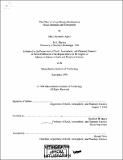The effect of a low density residuum on geoid anomalies and topography
Author(s)
Agner, Mary Alexandra
DownloadFull printable version (6.866Mb)
Advisor
Bradford H. Hager.
Terms of use
Metadata
Show full item recordAbstract
Recent seismological measurements of the Pacific oceanic structure have detected a positive correspondence between surface topography, seismic wave speed, and the geoid (gravitational potential). High seismic wave speed indicates cold material sinking, which pulls the surface downward. Thus, topographic lows are expected to correlate with seismic wave speed highs, contrary to the new seismic measurements. We propose models which include two segregated materials, representing the fertile upper mantle and the residue from crustal melting, in order to decouple the surface topography from subsurface convection and create a positive correlation between topography and wave speed. We add a low viscosity zone beneath the residue to enhance the density contribution to the geoid anomaly and ensure that its sign is in phase with that of the surface topography and wave speed. Our models produce surface topography and geoid anomalies comparable to the recent seismological measurements. These models offer constraints on the strength of the low viscosity zone as well as the density difference between the residue and the upper mantle.
Description
Thesis (S.M.)--Massachusetts Institute of Technology, Dept. of Earth, Atmospheric, and Planetary Sciences, 1998. Includes bibliographical references (p. 27-28).
Date issued
1998Department
Massachusetts Institute of Technology. Department of Earth, Atmospheric, and Planetary SciencesPublisher
Massachusetts Institute of Technology
Keywords
Earth, Atmospheric, and Planetary Sciences